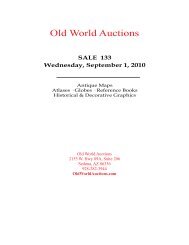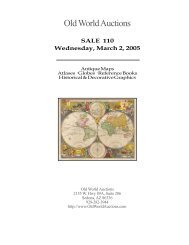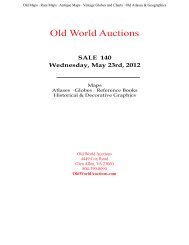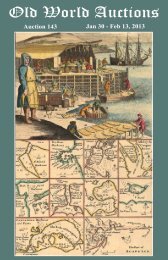PDF catalog - Old World Auctions
PDF catalog - Old World Auctions
PDF catalog - Old World Auctions
You also want an ePaper? Increase the reach of your titles
YUMPU automatically turns print PDFs into web optimized ePapers that Google loves.
<strong>Old</strong> Maps · Rare Maps · Antique Maps · Vintage Globes and Charts · <strong>Old</strong> Atlases & Geographies166. Colonial Mid-Atlantic (Carte de la Baye de Chesapeack et Pays Voisins pour Servir a l’Histoire Generale des Voyages), Bellin, Prevost’s Histoire Generale desVoyages, Paris, ca. 1757. 11.5 x 7.5”. (HC) Finely engraved colonial map covering most of Virginia, Maryland, Delaware with a bit of Pennsylvania and NewJersey. The interior is fully engraved with mountains and great detail along the rivers. An early network of trails and wagon roads are delineated, plus watershedand some topographical information. It extends west to beyond Fort Cumberland and locates Annapolis, Fredericksburg, Williamsburg, Norfolk, and Philadelphia.The delicate rococo-style title cartouche incorporates the distance scale. Ref: Sellers & Van Ee #1383; cf. Tooley (MCC 96) #875. Issued folding, now pressed onwatermarked paper with light offsetting and a tiny hole in border at top left. A binding trim at bottom right has been repaired with old paper, and an adjacent bindingtear that just enters map border has been archivally repaired. Two fold separations and a short tear in top blank margin have all been professionally repaired.(B+) $275-350167. Colonial Virginia, Maryland (A Map of the Most Inhabited Part of Virginia Containing the Whole Province of Maryland with Part of Pensilvania, New Jersey andNorth Carolina), Fry, Joshua & Jefferson, Peter, Thomas Jefferys’ American Atlas, 1775. 48.5 x 31”. (HC) By the middle of the 18th century, there was a strongneed for an updated map of the colony of Virginia, as no comprehensive map based on new surveys had been produced since Augustine Hermann’s map of 1673.George Montagu Dunk, Earl of Halifax and newly appointed president of the Board of Trade and Plantations in 1748, made this a top priority and immediatelyrequested new details regarding the extent of English settlement on the frontiers and the potential French encroachment in those areas claimed by the British. Inresponse to Lord Halifax’s request, the acting governor of Virginia, Lewis Burwell, appointed Colonel Joshua Fry and Peter Jefferson (the father of Thomas Jefferson)to draw an updated map of Virginia.Fry and Jefferson, then surveyor and deputy surveyor for Albemarle County respectively, were ideal appointees for the project as they had accumulated a substantialamount of information from their work on the backcountry, the Northern Neck controversy, and the westward extension of the border between Virginia and NorthCarolina. Their knowledge, along with reports received from their acquaintances who had explored the western territories, produced the most detailed account ofthe inhabited parts of the colony. In 1751, Fry and Jefferson produced a draft to governor Burwell (only one year after the request), and it was formally presentedto the Board of Trade and Plantations in 1752. A major revision in 1755 incorporated new information about the western frontier from information collected byFry, George Washington, and the journals of John Dalrymple and Christopher Gist.Cartographically, the map was the first to correctly orient the ridges of the Appalachian Mountains and the western flow of the New, Greenbrier and MonongahelaRivers. The map also depicts the “Great Waggon Road” that begins in Philadelphia and heads south through the Shenandoah Valley and into North Carolina. Bothof these important features would serve as paths toward future population flow and development. Numerous early plantations are located including landowner’snames. To the east the map shows the road from Williamsburg to Edenton, North Carolina and details the flow of rivers into Albemarle Sound.The title cartouche in the lower right corner illustrates the tobacco trade, which was the backbone of Virginia’s economy. The major rivers in the Tidewater regionwere critical to this industry as they allowed for direct transport of the crops from plantations to ocean-going vessels. Eliminating the need for land transportationmade the planters more profitable, and thus able to grow rapidly and capitalize on the significant amount of land accessible to the river system. Drawn by FrancisHayman and engraved by Charles Grignion, the vignette shows slave labor preparing the massive barrels of tobacco for transport to Europe while a wealthy merchantis served a beverage. At left a hogshead of tobacco spills onto the dock, visually representing the cornucopia or “horn of plenty.”This is the sixth state of eight known states. The first four states are essentially unobtainable. The fifth and sixth state are identical, with the only difference beingthe date change from 1768 to 1775. Published by Thomas Jefferys and Robert Sayer. Printed on four sheets and joined into two as issued, and would measure48” x 31” if fully joined. The image shows the map sheets overlaid as if they were joined. Ref: Stephenson & Mckee, pp. 52-55, 83; Pritchard & Taliaferro pp.154-159; Cummings (SE) #281, #449. Strong impression on watermarked paper in original outline color. There are some areas of light offsetting, most notably onthe upper sheet at left as well as some areas of light toning and a few minor spots. The map has been professionally removed from mounting board with the onlyevidence being some very light adhesive residue on verso that is not visible on the face of the map. (B+) $32000-40000168. Colonial Mid-Atlantic (A Chart of Delaware Bay and River, from the Original by Mr. Fisher of Philadelphia - 1776), Anon., Gentleman’s Magazine, [1779]. 9.2x 7.2”. (BW) This Revolutionary War map was based on the chart Joshua Fisher made of Delaware Bay in 1756 and expanded upon in 1776. The Fisher mapwas the most important map of the bay and river in the eighteenth century. This map was derived from the 1776 edition, and was published with an article updatingthe British public on the war in the colonies. It shows the bay and beyond to Philadelphia and is filled with place names and the location of many hazards tonavigation along the waterway. Locates Cape May, Turtle Gut Inlet, Cape James, Egg Island, Salem, and much more. Two distance scales and the direction rosewith fleur-de-lis orients north to the right. Published in the July, 1779 issue of the Gentleman’s Magazine. Ref: Jolly #GENT-268; Sellers & Van Ee #1372. Issuedfolding with one faint spot below distance scale. (A) $200-240169. Mid-Atlantic United States, Chesapeake and Delaware Bays (A Chart of the Chesapeake and Delaware Bays), Lucas, Baltimore, 1852. 28.3 x 40”. (HC) Thislarge-scale sea chart of the Chesapeake and Delaware Bays is one of the most decorative and desirable charts of the area. The chart depicts great detail from theentrances to the bays on the Atlantic Ocean to Washington D.C., Baltimore, and Philadelphia, and extending up the James, York and Rappahannock rivers. Miniaturebird’s-eye plans of the key cities are shown, adding to the attractiveness of this chart. The waters are filled with soundings, shoals and other navigational hazards.Four profile views of the coast are depicted - Cape Henry, Smiths Point Light House, Windmill Point, and Cape Henlopen - three of which include lighthouses.Lighthouses and Light Boats are marked throughout the chart with notes about the lights at each. Another noteworthy feature is the inclusion of tide tables forboth bays. Engraved by John and William Warr and sold by Hagger & Brother, a prominent Baltimore merchant of nautical charts in the mid-nineteenth century.Originally published in 1832, several editions appeared through 1862. This example has corrections through 1852. Printed on two sheets, joined as issued andmounted on original linen with the Hagger & Brother label on verso.Fielding Lucas, Jr. was a successful cartographer and map publisher in Baltimore. Lucas is best known for his General Atlas of 1823, which is considered one ofthe finest general atlases produced in the U.S. at the time, due to the high quality paper, superior engraving quality, and attractive coloring style. This chart is theonly chart known to be published by Lucas. It is significant for the innovative use of color to distinguish the navigational hazards and lighthouses. Ref: Guthorn,p. 78. Original color, lightly refreshed, with soiling and some creases and cracks that have been professionally repaired. There are minor abrasions just belowtitle, where a previous Hagger & Brothers pastedown label has been removed. A very nice example of a sea chart that was intended for heavy use. (B)$8000-10000170. Colonial Southeast (Virginia et Florida), Mercator/Hondius, Atlas Minor, Amsterdam, [1609]. 7.2 x 5.8”. (HC) This is a reduced version of Hondius’ folio mapof the same title. It was based on John White’s Virginia and Jacques le Moyne’s Florida as interpreted by Theodore de Bry. Numerous Indian villages are shownthroughout and in the Apalacci Montes there is a notation concerning the presence of both gold and silver, and below lies the fictitious Lacus Dulcis, more commonlycalled Lake May. Decorated with strapwork scale of miles and title cartouches. This is from the only German edition of Hondius’ Atlas Minor, with German texton verso. Ref: Burden #155; Cumming (SE) #27. Marginal soiling and faint text show-through. (A) $550-650171. Colonial Southeast (Virginiae Partis Australis, et Floridae Partis Orientalis, interjacentiumq Regionum Nova Descriptio), Jansson, Le Nouveau Theatre du Monde,Amsterdam, ca. 1639. 19.8 x 15.3”. (HC) This lovely map of the Southeast extends from the southern part of Chesapeake Bay to northern Florida. This is the firststate of Jansson’s map, which is virtually identical to Blaeu’s map of 1638. Cartographically it improves on the Hondius map of 1606, on which it was derived,with Chesapeake Bay correctly indicated as a large bay and the Carolinas and Georgian coasts depicted more accurately. The map presents the English and Frenchcolonial interests in the region as depicted by their respective royal arms. At the southern end of the Appalachians is a note concerning gold and silver mines.Richly decorated with a large cartouche flanked by Native Americans. The Atlantic Ocean contains two compass roses, three sailing ships and two aquatic puttiholding the German scale of miles. French text on verso, published between 1639-42. Ref: Burden #254; Cumming (SE) #42. <strong>Old</strong> color and wide margins withlight toning and a centerfold separation that enters map image 2” at bottom that has been professionally repaired. A short tear and a small hole in bottom blankmargin have also been professionally repaired, and there is light soiling in blank margins. (B+) $1600-1800172. Colonial Southeast (Carte de la Caroline et Georgie pour Servir a l’Histoire Generale des Voyages), Bellin, Prevost’s Histoire Generale des Voyages, Paris, 1757.11.3 x 7.4”. (HC) Delicately engraved map of the colonies of Carolina and Georgia from Albemarle Sound to the Alatamaha River. It probably owes its origin to
















